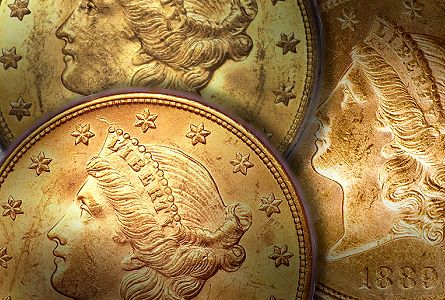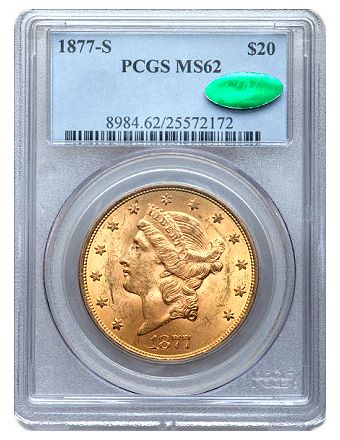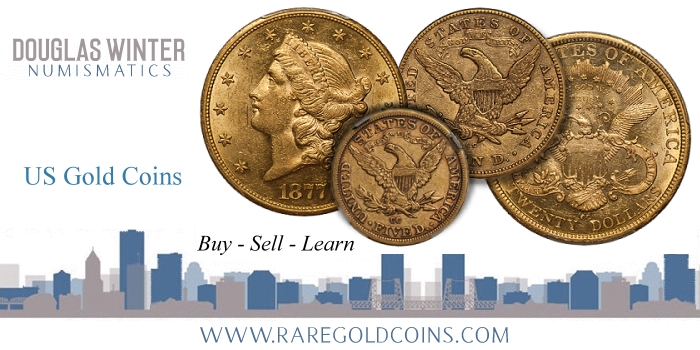By Doug Winter – RareGoldCoins.com ……
CoinWeek Content Partner ……
If you collect rare United States gold coins, you’ll notice that certain series have extremely compressed values. As an example, a common date Dahlonega half eagle grades EF45 might trade in the $2,300-2,600 range while the same date in AU50 often sells for a small premium; maybe as low as 10-15%.
 The reason for this is pretty simple. The market has decided that there is not much of an aesthetic difference between a Dahlonega half eagle in EF45 and one in AU50 and the formerly high price premium between the two grades is no longer merited. But there are some series where one small point on the grading scale can make a significant financial difference. One of these is Type Three double eagles.
The reason for this is pretty simple. The market has decided that there is not much of an aesthetic difference between a Dahlonega half eagle in EF45 and one in AU50 and the formerly high price premium between the two grades is no longer merited. But there are some series where one small point on the grading scale can make a significant financial difference. One of these is Type Three double eagles.
The Type Three double eagle series dates from 1877 through the adoption of the new St. Gaudens designs in 1907. Type Three double eagles range from ultra-common to ultra-rare and they have proven to be quite popular with collectors over the last decade.
The grade distribution for most Type Three double eagles dictates their current rarity. By this, I mean that many dates were extensively melted and the surviving coins tend to have been shipped loose in bags to overseas sources. There are many Type Threes that are virtually unknown in grades below AU55 and virtually unknown in grades above MS63. When available, they tend to be heavily abraded due to poor handling and grade in the MS60 to MS61 range.
The exact point on the grading scale where availability and non-availability in this series tend to intersect is at MS63. There are numerous Type Threes that are fairly scarce in properly graded MS62 but are still affordable and, in my opinion, are very good values. These same coins might double, triple or even quadruple in price at the next grade up and I question the value of these MS63 coins. This is especially true when a nice, high-end MS62 is often virtually indistinguishable from a typical quality MS63.
There are a number of “secret” and “not-so-secret” dates in the Type Three series that I think make for interesting analysis.
Let’s look at a few of these and determine what the best grade is for the collector seeking good value.
1. 1877-S There were three different Liberty Head double eagles issued in 1877 and the 1877-S is the most common of these. It is a numismatically significant date as it is the first San Francisco Type Three double eagle but it is very common in the lowest Uncirculated grades. As I was doing some basic research for this blog, I was very surprised to see the third-party population figures for MS62 examples of this date: 258 graded as such at PCGS and 163 at NGC. Even factoring in extensive resubmissions, this is still well over 100 examples graded MS62 between the two services.
 In MS62, the 1877-S is worth around $4,000-5,000. This seems like a fairly high number for a coin that is more available than I would have thought but most 1877-S double eagles in MS62 are very low end. CAC has only approved four (with none higher) and this low number doesn’t surprise me. I’d have to say that a choice, minimally abraded MS62 with CAC approval is pretty good value at, say, $4,500-5,000.
In MS62, the 1877-S is worth around $4,000-5,000. This seems like a fairly high number for a coin that is more available than I would have thought but most 1877-S double eagles in MS62 are very low end. CAC has only approved four (with none higher) and this low number doesn’t surprise me. I’d have to say that a choice, minimally abraded MS62 with CAC approval is pretty good value at, say, $4,500-5,000.
In MS63, this date is conditionally rare. PCGS has graded 25 (with three better) while NGC shows only five with one better. An average quality MS63 is worth around $15,000 while a choice, high-end piece could bring close to $20,000 at auction; more if it were CAC approved. Is this issue good value in MS63? I would have to say no, especially if the coin in question looks like the few slabbed MS63′s that I’ve seen in recent years. My advice to the collector would be to patiently wait for a nice MS62 and pay a premium of as much as 10-15% if the coin has above-average luster and surfaces.
2. 1879 This is one of the more interesting years, numismatically, for Type Three double eagles. Four different issues were struck. The 1879-O is the rarest, followed by the 1879-CC. The 1879-P and 1879-S are condition rarities with similar overall profiles.
The 1879 is most often seen in AU55 to MS60 grades and it is very scarce in properly graded MS61. Nice MS62′s are rare. PCGS shows a population of forty-five in this grade with twenty-one finer while NGC’s figures are 32 with 19 finer. Only two MS62′s have received CAC approval. In MS62, this coin has a current value of $4,500-5,000. This seems to me to be a great value in comparison to the above-referenced 1877-S.
In MS63 and higher grades, the 1879 is very rare. The combined PCGS/NGC population is twenty-five in this grade with fifteen finer. Factoring in resubmissions, this means there are perhaps a dozen known in MS63 or above. In the current market, such a coin would sell for $15,000 to $20,000. Do I think an MS63 is worth three to four times more than an MS62? Not really. Would I advise a collector to buy an MS63 example of this date? Doubtful, unless he was putting together a finest known/Condition Census set and he “had” to have a coin that graded at least MS63.
3. 1889. This date differs from the 1877-S and 1879 in that it isn’t a total condition rarity. It has a reasonably low original mintage of 44,111 business strikes; a fraction of the number made for the 1877-S and the 1879.
This is an issue that didn’t see a lot of circulation and it is seldom encountered in AU grades. But it is fairly easy to locate in MS60 and MS61. MS62 coins have a relatively high population (over 300 at PCGS and NGC combined) but many of the examples that I see in MS62 holders are not really all that special. This is evidenced by the fact that only five coins (as of 5/12) have received approval at CAC. An MS62 example of the 1889 can currently be purchased for $3,000-3,500.
MS63 and higher examples are another story. PCGS has graded 19 in MS63 with none better while NGC shows five in this grade with none better. We can assume the PCGS population is inflated and, in all likelihood, the number of properly graded MS63 coins is around six to eight. The value of this date in MS63 is in the $12,500-15,000 range. Is this is a good value?
In this case, I think that a really nice CAC-quality 1889 $20.00 in MS63 might be a pretty good deal at around $13,500. Here’s my thought process. First of all, there are no coins currently graded higher than MS63. Secondly, with a reasonably low mintage figure you probably don’t have to worry about extensive hoards being found. Thirdly, it is common in MS62 but few of the coins in this grade seem to be nice enough to upgrade, someday, to MS63. This makes it a reasonably “safe” condition rarity although, as always, there is some risk involved with a coin like this.
As you can see from the examples above, the “best value grade” for all these dates–and for many Type Three double eagles–is MS62. If you can find examples of these dates in high-end CAC-quality MS62, at a fraction of the MS63 price, it is hard to argue with these levels of value.

* * *
About Doug Winter
 Doug has spent much of his life in the field of numismatics; beginning collecting coins at the age of seven, and by the time he was 10 years old, buying and selling coins at conventions in the New York City area.
Doug has spent much of his life in the field of numismatics; beginning collecting coins at the age of seven, and by the time he was 10 years old, buying and selling coins at conventions in the New York City area.
In 1989, he founded Douglas Winter Numismatics, and his firm specializes in buying and selling choice and rare United States coins, especially US gold coins and all branch mint material.
Recognized as one of the leading specialized numismatic firms, Doug is an award-winning author of over a dozen numismatic books and the recognized expert on US Gold. His knowledge and an exceptional eye for properly graded and original coins has made him one of the most respected figures in the numismatic community and a sought after dealer by collectors and investors looking for professional personalized service, a select inventory of impeccable quality and fair and honest pricing. Doug is also a major buyer of all US coins and is always looking to purchase collections both large and small. He can be reached at (214) 675-9897.
Doug has been a contributor to the Guidebook of United States Coins (also known as the “Redbook”) since 1983, Walter Breen’s Encyclopedia of United States and Colonial Coins, Q. David Bowers’ Encyclopedia of United States Silver Dollars and Andrew Pollock’s United States Pattern and Related Issues
In addition, he has authored 13 books on US Gold coins including:
- Gold Coins of the New Orleans Mint: 1839-1909
- Gold Coins of the Carson City Mint: 1870 – 1893
- Gold Coins of the Charlotte Mint: 1838-1861
- Gold Coins of the Dahlonega Mint 1838-1861
- The United States $3 Gold Pieces 1854-1889
- Carson City Gold Coinage 1870-1893: A Rarity and Condition Census Update
- An Insider’s Guide to Collecting Type One Double Eagles
- The Connoisseur’s Guide to United States Gold Coins
- A Collector’s Guide To Indian Head Quarter Eagles
- The Acadiana Collection of New Orleans Coinage
- Type Three Double Eagles, 1877-1907: A Numismatic History and Analysis
- Gold Coins of the Dahlonega Mint, 1838-1861: A Numismatic History and Analysis
- Type Two Double Eagles, 1866-1876: A Numismatic History and Analysis
Finally, Doug is a member of virtually every major numismatic organization, professional trade group and major coin association in the US.




